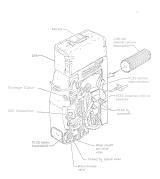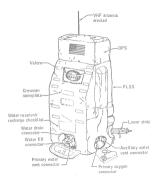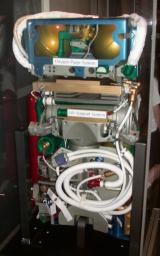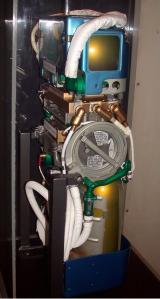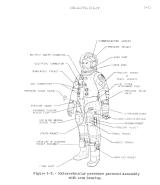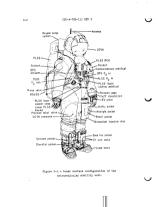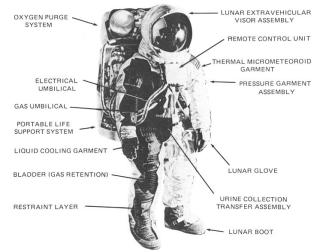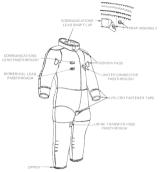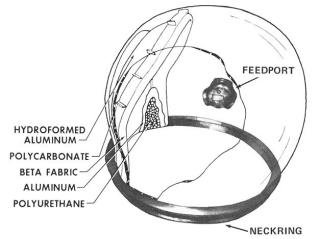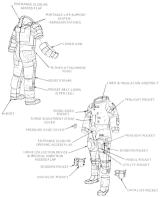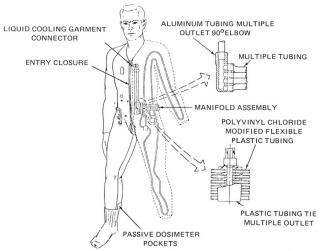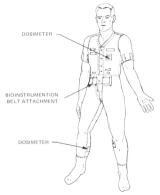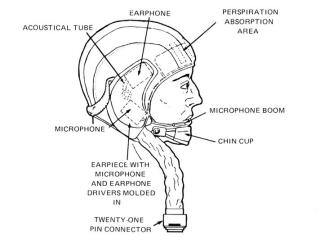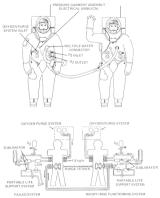NASA Apollo project Space Suit(A7LB PGA)
- temperature endure to : from -290 to +310 Fahrenheit (from -179 to +154 Celsius)
- inner pressure : 3.70 - 3.90 pound / square inch
- running time : 7 hours(continuously), 160 hours(total)
- weight : approximately 180 pound (all equipments include PLSS)
- manufacturer : Space suits : International Latex Corp.(ILC DOVER Inc. at present) Back Pack (PLSS) : Hamilton Standard Division of United Aircraft Corp., Windsor Locks, Connecticut


Overview
We must need special made "Space Suit" to protect mankind from hard temperature change, vacuum, micrometeoroid in space. On the moon, it becomes 120 degree Celsius (250 Fahrenheit) at daytime, and -157 degree (-250) at nighttime. And micrometeoroid pours in 102,400km/h(64,000mph), exposed in harmful ultraviolet rays from the sun. So, we can not live in space for only few seconds without Space Suits.
History
Space suit in Mercury project, it was improved product from pressure suit of U.S. Navy high altitude jet fighter. This was not complete airtight suit. This was back up for spacecraft's pressurization. In Gemini project, joint mechanism was developed for bend arms and legs in pressurized environment by U.S.Airforce's research. It had a combination of a pressure bladder and a link-net restraint layer that made the whole suit flexible when pressureized. In Apollo project, it must have to offer protection from jagged rocks and the searing heat of the lunar day. And had to be flexible enough to permit gathering samples from the moon surface.


Model numbers
The space suit used for Apollo project was called A7L / A7LB. The head character 'A' means Apollo project. Second character '7' means model number. Third 'L' means manufacturer. In Apollo project, from earlier A1C to last A7LB, 15 types of space suits were developed. Type A6L suit was used at Apollo One, but because of fire, fireproof A7L suit was developed and used from Apollo 7. Then after Apollo 15 (J mission), more improved A7LB suit was used. This suit was used even SkyLab, ASTP projects. After that, A8L type was developed but not used.

Manufacturing
In Apollo project, all space suits were fully tailor-made, made for each astronauts, used it once and then throw. And 15 suits were made in each mission. One for actually misson, one for training, one for spare for each primary crew, so 3 x 3 = 9 suits. Then for each back-up crew, one for actually misson, one for training, so 2 x 3 = 6 suits. So, they become 15 suits all together.
Against that, space suits for space shuttle are reuseable because of functionallity of changing size by replacing each parts. At NASA Johnson Space Center in Houston, many parts which can combine about 50 suits are stocked now.
Price
Many company are making each parts, and it's structure will be change by each misson, so it's very difficult that calculate price of one space suit. One day, some news media reported that it's cost was about 2 million dollers. It becomes more than tat when it used at once like Apollo.

Structure
Inner space suit was made by 20 to 21 layered special material developed by Du Pont company. These are type of nylons and new material called Kapton film. And the most outside was covered by Teflon coated glass fiber beta cloth. For reflect sun heat and keep comfortable temperature, suit was colored as white. Form Apollo 13 to 17, captain wore red belt on elbows and knees.
Apollo space suit was formally called 'Pressure Garment Assembly (PGA)'. And the full set of suit include life-support system was called 'Extravehicular Mobility Units (EMU)'. 100 percent oxygen was provided in this PGA.

Operation
In Apollo project, PGA was used in two different form. One is 'Intravehicular:IV' form called 'CMP A7LB PGA'. Another is 'Extravehicular:EV', on the moon or out of spacecraft, called 'EV A7LB PGA'.

In the knee, wrist, shoulder, elbow, ankle, thigh region of CMP A7LB PGA, special made joints were integrated for bend easily in pressurized circumstances. And for EV A7LB PGA, in addition to these, neck and waist joints were integrated. The center of the back, from neck to thigh, restraint and pressure-sealing zippers was provided on CMP A7LB PGA. Astronaut donned space suit from here. EV A7LB PGA has entrance zippers extend from the left side of the waist, around the back to the right side of the waist, and diagonally up to the right chest area of the suit. Astronaut oneself can handling these zippers, but normally colleague operate this.
Intravehicular suits
Intravehicular suits include following units.
- fecal containment subsystem
- constant wear garment : underclothes
- biomedical belt : sensor to collect biomedical informations
- urine collection transfer assembly : urine collecting unit
- torso limb suit assembly(TLSA) : body of space suit
- integrated thermal micrometeoroid garment(ITMG) : pressure skin
- pressure helmet : cover astronaut's head
- pressure glove : cover astronaut's hand
- communications carrier : make comminication with Houston
Extravehicular Mobility Units
Extravehicular Mobility Units was composed by remove constant wear garment from Intravehicular suits and add following 5 units.
- liquid-cooling garment : underclothes cooled by liquid
- lunar extravehicular visor assembly(LEVA) : wear on the pressure helmet
- lunar extravehicular glove assembly : wear on the pressure glove
- lunar overshoe : wear on the boots of TLSA
- cover which fits over umbilical connections

Torso and Limb Suit Assembly (TLSA)
The skin of space suit was layered from this TLSA and outer ITMG. TLSA is three layered, and covers all of body except head and hand. And connected with helmet and gloves. The body part of TLSA was custom made for each astronaut. The torso part was selected from some fixed size unit. In this TLSA, oxygen duct and electrical cables for communication were integrate. A pressure gauge to measure pressure in the suit is installed on the right wrist. And an exhaust valve for exhaust oxygen when the pressure go over 5.5psi is installed on the left wrist.

Integrated Thermal Micrometeoroid Garment (ITMG)
This outer ITMG is for insulate heat and micrometeoroid, and connected to extravehicular visor, lunar overshoe. This is made by seven layered aluminized Kapton film, six layered Beta Marquisette, two layered Neoprene-coated nylon Ripstop, sandwiched between beta cloth. The knees, elbows and shoulders were protected by Chromel-R. On the left upper arm, a pocket for pens and penlights is stitched. And on the right upper arm, a pocket for sunglasses, on the right upper thigh, there is a utility pocket. On both legs, strap on pockets for data-list (left) and check-list, scissors(right) are stitched. On the back, for avoid wear with PLSS, Teflon patch was stitched.
Connectors

| position | color | function |
|---|---|---|
| right upper | blue | electrical,biomedical and communication connector |
| right middle | blue | oxygen inlet |
| right lower | red | exhaust outlet |
| left upper | blue | double water connector |
| left middle | blue | oxygen inlet |
| left lower | red | exhaust outlet |

Pressure helmet
This helmet was made of polycarbonate (plastic), and connected to TLSA by aluminum pressure-sealing neckring. This helmet was fixed to spacesuit, and do not move while astronaut moves his head. There is a feed port on the left side to connect air valve. A vent pad was contained on the back.

Lunar extravehicular visor assembly(LEVA)
This visor assembly containes two visors, two side eyeshades, and a center eyeshade. The outer sun visor employs a gold coating to reflect sun heat and light. And the inner protective visor is transparency, and coated for obstruct running heat away. These visors and shades are adjustable.
Lunar overshoe

pressure glove & extravehicular glove

Extravehicular glove was worn over the pressure glove. This is covered by Metal-woven fabric or Chromel-R, and the fingertips are fitted with silicone rubber caps. This outer glove extends over the pressure glove - TLSA juncture.
PLSS : back pack


REMOTE CONTROL UNIT(RCU)

Space Watch

In addition, in consideration for use in zero gravity, 'PROFESSIONAL' wind-up model were chosen for astronauts, instead of self-winding 'AUTOMATIC'.
-
OMEGA SPEEDMASTER PROFESSIONAL MODEL 3570.50

The latest model of normal PROFESSIONAL. Movement is different, but this is the series used in the Apollo program. For safe even broken in harsh environments, the glass is made of Plexiglas (A kind of plastic), but is vulnerable to scratches. Design is refined many times, the details are different from the days of the Apollo program.
-
OMEGA SPEEDMASTER PROFESSIONAL MODEL 3573.50

Special model of PROFESSIONAL. The back cover is transparency for visible inside mechanism. The glass is made of Sapphire glass, so is strong in the wound.
Space pen
In the zero-gravity environment, a normal ballpoint pen can not be used. Fisher's proprietary "Space pen", it has pressurized ink cartridge with 35psi nitrogen and tungsten carbide pen tip, can write under the environment of zero gravity, water, 12,500 feet (3800m) of altitudes, ?30 to 250 °F (?35 to 120 °C) temperatures range, in any angle. Although NASA was using a mechanical pencil in the space, considering the risk when floating broken pen tip, they developed a pen that can be used in space with considerable expense, but not succeeded. In 1965, Mr. Paul C. Fisher : Founder of Fisher's, recommended this pen to NASA, they decided to adopt it in the Apollo program. It is said that in 1967, NASA has purchased 400 pens for $6 a piece. In addition, Space pen that was used in the Apollo program is a model called the AG7 "Astronaut pen".
-
Fisher Space Original Astronaut Space Pen

Chrome Plated Astronaut Space Pen. This is the original Fisher Space Pen that was used on the Apollo 7 space mission in 1968 after 2 years of testing by NASA and has been used on all manned space flights since then. The design and construction of this pen has not changed in 36 years. The pen you buy today is exactly the same as the one taken to the moon in 1969. It is a heavy pen and the weight rests reassuringly in your hand as you write. The AG7 is made from solid brass with an extremely hard Chrome plating. It has a very positive and substantial feeling click mechanism. You press down on the top to extend the refill and press the side button to retract the refill. It's special design assures you that you'll always retract the point before you slide it in your pocket. It's constructed of all brass and steel components of the highest quality and is made in the USA. All Astronaut Pens are attractively packaged in heavy duty gift boxs with flock lining and come with a pamphlet describing the history of the Fisher Space Pen. Used on all NASA Apollo and Shuttle missions, ISS International Space Station, Russian Soyuz and MIR space flights, French ARIANE Space Program, Everest North Face Ski Expedition. This item come in a original box from the manufacturer.
Space suit in movies
Space suits in movies are all imitation for film, not rent from NASA. In the movie "APOLLO 13", space suit was made by SPACE WORKS. And in "FROM THE EARTH TO THE MOON", it was made by GLOBAL EFFECTS INC.
Astronauts figure
All space suit pictures on this web page are taken from action figure NASA APOLLO ASTRONAUT 'BUCK' made by Dragon Models. Look at Apollo scale models page for more informations.
Related Links
Related books and videos
-
1/6 action figure Apollo 17 captain ' Eugene Cernan '

Hobbymaster USD199.99
1:6 Scale Highly Detailed Action Figure of Captain Gene Cernan The Last Man On The Moon Limited Edition Ships promptly from Minneapolis when orderd from Historic Avation Lovley detailed display piece
-
U. S. Spacesuits

Springer 2011/11/02 USD35.96
Spacesuits are far more than garments. They are a personalized spacecraft that allows direct contact and interaction with everything beyond our world, and a last refuge for survival in a disaster. Creating safe, reliable, and comfortable spacesuits is an ongoing challenge that has spanned over four decades. "U. S. Spacesuits, 2nd Edition" by Kenneth S. Thomas and Harold J. McMann details the technical evolution of U. S. spacesuits from their roots in high altitude aviation and vacuum tube development to present day, with an additional look into the future. This primary source of spacesuit information explains the functions, historical development, and use of spacesuits from a worldwide perspective. In this new edition, the authors update the story of U.S. spacesuit development and efforts, from the design challenges modern engineers face to the latest roles of spacesuits in space exploration.
-
Dragon Models 1/6 Apollo Astronaut

Dragon Models 2011/7/21
An award winning line of highly detailed and historically accurate action figures. Each figure has its own name, unique headsculpt and numerous accessories. Character head (life-like sculpts). Lunar Extravehicular Visor Assembly (LEVA). Integrated Thermal Micometeoroid Garment (ITMG). Portable Life Support System (PLSS). PLSS Remote Control Unit (RCU).
-
Spacesuits: The Smithsonian National Air and Space Museum Collection

powerHouse Books 2009/5/26 USD19.77
The goal of landing a man on the Moon and returning him safely to Earth required the development of three things: spacecraft, launch vehicles, and protective clothing. Spacesuits: Within the Collections of the Smithsonian National Air and Space Museum takes the reader through the development of the last category, the spacesuits used during this venture. Highlighting the pressure suits created during the years leading up to the lunar missions and beyond, this book features dramatic photographs of the Smithsonian’s collection, as well as never-before-published historical images of spacesuit development and testingge-of-motion studies, for example, in which researchers wore spacesuits while playing baseball and football. The book also includes a group of advanced spacesuits, which, though never used on a mission, are in many respects the most exciting suits ever created. One suit glove has steel fingernails and sharkskin pads, in an attempt to harness the abilities of the human hand.
-
US Spacesuits

Springer-Verlag 2006/1/31 USD39.95
The authors will provide both the reader with an appreciation of spacesuits and US suit efforts, through development challenges to their role in space exploration. The text will explain how the routine use of clothing provides a link to the function of spacesuits and why spacesuits are far more than garments. They are a last refuge for survival in disaster or a personalized spacecraft that allows direct contact and interaction with everything beyond our world. Successfully meeting the challenges to creating safe, reliable and comfortable spacesuits is an ongoing effort that has spanned over four decades. The book will detail the technical evolution of U.S. spacesuits from their roots in high altitude aviation and vacuum tube development to the present day, with an additional look into the future. This primary source of spacesuit information will explain the function, historical development, and use of spacesuits from a worldwide perspective in a readable way. The story includes many technically and historically interesting efforts that never reached flight, and were either misunderstood or not widely reported.
-
Russian Spacesuits

Springer-Verlag 2003/8/27 USD39.95
Russian spacesuits is a unique contribution to space science. The authors, part of the original Zveda team that manufactured spacesuits for the first Russian space flights, still play an integral role in spacesuit research and development. Thus there is no-one better to describe the technical innovations of the past 40 years, which enabled Gagarin's first flight in 1961, the first space walk in 1965 and the Mir missions of the 1980s and 1990s, and which have culminated in today's International space Station. The authors also describe how the political climate within the Soviet Union and internationally has affected the development of the space programme and their work. Many documents are published for the first time that, together with photographs, detailed descriptions of the events of the time and the authors' personal memories, provide a fascinating review of a previously unknown aspect of space science




